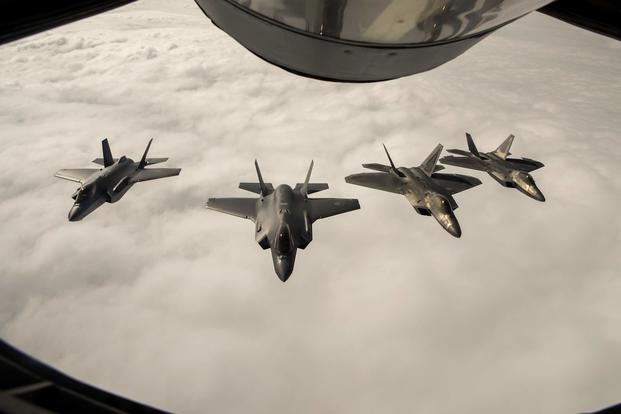NORWAY -- The Royal Norwegian Air Force is gearing up to use its F-35 Joint Strike Fighters for its alert mission, intercepting incoming Russian aircraft as they fly into Norwegian airspace.
Before that happens, Norwegian pilots want to train alongside the U.S. Air Force, and will do so in the next few weeks as the biennial Arctic Challenge exercise kicks off in the high north, the term used for the region encompassing the Nordic countries and the Arctic, according to officials in the Ministry of Defense and Ministry of Foreign Affairs.
It will mark Norway's first major exercise for its F-35A variant.
"The U.S. Air Force is a huge reinforcement or potential. We are not enough," said Svein Efjestad, policy director for the department for security and policy operations at Norway's Ministry of Defense.
Efjestad said that pairing with the U.S. in the exercise will bring volume, "tactical training" and advancement.
Related content:
- Most Russian Plane Intercepts over Baltics Due to Error: NATO General
- Beluga Mystery: Will Norway Keep 'Spy Whale'?
- 'America's Tall Ship' Makes First Visit to Norway Since 1963
"We do not have the capacity to build on this knowledge ourselves; we have to draw on the bigger partners," he said in an interview. Military.com spoke with officials here as part of a fact-finding trip organized by the Atlantic Council, a Washington, D.C.-based think tank, under the auspices of its partnership with the Norwegian Ministry of Defense.
Some officials provided remarks on background in order to speak freely on various subjects.
The purchase of the F-35 "was a big step forward in the country. It's not a given we should only focus on the high-end capability, but [rather speaks to] what kind of doctrine should we apply for [our future]," said a top official from the Ministry of Foreign affairs, citing the need to build and strengthen a coalition.
The foreign ministry official added, "The risk of strategic misunderstanding is better when [using the F-35] … in the high north."
Norway anticipates housing some F-35s at a northern forward operating location in Evenes for the alert mission.
Officials said they would welcome additional interoperability flights with the U.S. and allies to mix and match capabilities.
With the growing international interest in the Arctic, allied militaries could learn more about Russia's expanding activities in the region, including GPS jamming and how to thwart or manage hostile action, they said.
Norway is also part of the NATO rotation to conduct Baltic Air Policing, or scrambles on behalf of the Baltic states, which lack capable air forces. The plan is to use F-35 for that mission too.
Just next door, Russia has been spotted moving equipment -- including the S-400 Triumf surface-to-air missile system -- into the Kola Peninsula, which directly borders Norway, Finland and the Barents Sea.
The buildup of SAMs is presumed to be an effort to protect Russia's maritime second strike capability in the region -- possible nuclear retaliation in response to an initial nuclear launch from an attacker. Russia operates its nuclear-powered and conventional submarine missions from the Barents Sea.
As with any new program, as Norway's F-35A inventory grows, flights are expected to increase, an MoD official said.
Lately "we tease the Finns and the Swedes with our activity, saying, you've [missed it] because you haven't seen us," the defense official said.
The Nordic Defence Cooperation, known as NORDEFCO, which operates as a defense alliance network, said Thursday it will inform Russia of the upcoming Arctic Challenge drills.
More than 100 aircraft -- roughly one-fourth of them belonging to the U.S. -- and one thousand personnel are expected to participate in the flag-level drills that will span Bodø Air Station in Norway, Luleå in Sweden and Rovaniemi in Finland from May 20 to June 5.
Three new stealth fighters arrived this week at Ørland Main Air Station, boosting the country's inventory to 12. Seven aircraft belonging to Norway are still at Luke Air Force Base, Arizona.
Manufacturer Lockheed Martin Corp. is scheduled to deliver six aircraft to Norway each year. By September, the country will have 15 aircraft, the minimum needed to declare initial operating capability for the fighter. The government expects to achieve IOC by the end of the year and to fully transition to the F-35 from the F-16 Fighting Falcon by 2022.
"There was this realization that, in order to operate in conflict, you have to go top of the line … and conjointly with the U.S. Air Force," the foreign ministry official said.
Much like in the U.S., the F-35 program here hasn't been without growing pains.
Buying into the U.S.-led program marked the thinly populated country's largest and most expensive procurement when officials announced in 2008 that Norway had chosen the fifth-generation jet with a plan to eventually buy 52 aircraft.
It has been recently reported that the country is struggling to boost its personnel to efficiently maintain the jet. There has been a "dip" in maintainers transitioning from the F-16 to the F-35 because of the difference in technicality of the two platforms, officials here said.
But they said that issue is not unexpected, occurring whenever something new enters the equipment inventory.
The F-35 is seen as a necessity regardless of the initial challenges, officials said.
"Yes, it's expensive, but it's necessary," the MFA official said, speaking from a policy and future strategy perspective.
-- Oriana Pawlyk can be reached at oriana.pawlyk@military.com. Follow her on Twitter at @Oriana0214.












